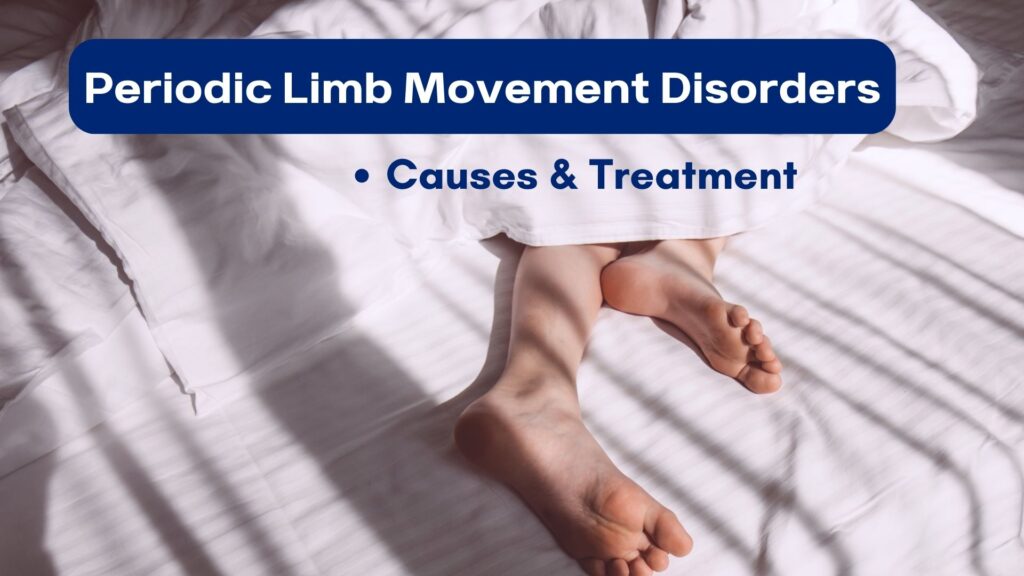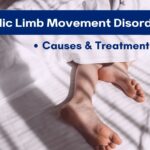Periodic Limb Movement Disorder (PLMD) is a neurological sleep disorder characterized by repetitive and involuntary limb movements during sleep. These movements typically occur in the legs but can also affect the arms. Unlike restless legs syndrome (RLS), which involves uncomfortable sensations in the limbs prompting movement, PLMD movements often occur without the person being aware of them. These movements can disrupt normal sleep patterns, leading to fragmented sleep and excessive daytime sleepiness. PLMD is diagnosed through sleep studies, specifically polysomnography, which monitors brain waves, muscle activity, and other physiological parameters during sleep.
Symptoms of PMLD
Periodic Limb Movement Disorder (PLMD) primarily affect the legs, including the feet and toes, although they can also involve the arms. Unlike voluntary movements or those associated with REM sleep behaviour disorder, PLMD movements occur involuntarily and are not consciously controlled by the individual.
The distinctive feature of PLMD is the periodic nature of these limb movements, occurring at regular intervals throughout the night. These movements can vary in intensity and duration but typically involve rhythmic flexion or extension of the limbs, often resembling kicking or twitching motions. These movements may occur every 20 to 40 seconds and can persist for several minutes at a time.
Also Read: What happens when we sleep?
One of the challenges with PLMD is that individuals are often unaware of these movements because they occur during sleep. However, bed partners or family members may notice repetitive limb movements, especially if they cause disruptions in bed or audible sounds. Despite the lack of conscious awareness during sleep, PLMD can significantly impact sleep quality and overall restfulness.
The consequences of PLMD-related sleep disturbances can manifest during waking hours. Common symptoms include excessive daytime sleepiness, fatigue, and difficulty staying alert or focused during daily activities.
It’s important to note that PLMD is distinct from restless legs syndrome (RLS), although they may coexist in some individuals. RLS is characterized by uncomfortable sensations in the legs (such as itching, crawling, or tingling) that prompt a strong urge to move the legs for relief. In contrast, PLMD movements occur without these preceding uncomfortable sensations.
Also Read: Restless Leg Syndrome – Treatment & Impact on Sleep
Diagnosis of PMLD
Diagnosing Periodic Limb Movement Disorder (PLMD) involves clinical evaluation and objective sleep assessments. Physicians typically begin with a detailed medical history and physical examination to identify symptoms suggestive of PLMD, such as sleep disturbances and daytime fatigue.
One of the primary diagnostic tools for PLMD is a comprehensive sleep study or polysomnography (PSG). PSG monitors various physiological parameters during sleep, including brain waves (electroencephalography), muscle activity (electromyography), eye movements (electrooculography), and respiratory patterns.
Surface electrodes placed on the legs detect limb movements, including the frequency and duration of limb movements. The International Restless Legs Syndrome Study Group (IRLSSG) defines PLMs as repetitive limb movements lasting at least 0.5 seconds and separated by intervals of 5-90 seconds. A PLM index (PLMI) quantifies the frequency of PLMs per hour of sleep. A higher PLMI values indicate more frequent limb movements.
In addition to PSG, other diagnostic tools may include actigraphy. Actigraphy records limb movements using a portable device worn on the wrist or ankle. It can provide data on sleep-wake patterns and can supplement PSG findings in diagnosing PLMD, especially in home-based monitoring scenarios.
Clinical judgment, supported by objective sleep measures, is important to differentiate PMLD from other sleep disorders such as restless legs syndrome (RLS), periodic limb movements during wakefulness (PLMW), and other sleep-related movement disorders.
Also Read: Sleep Apnea, Snoring & Treatment Methods
What causes PMLD?
Periodic Limb Movement Disorder (PLMD), a complex sleep-related movement disorder, develops and manifests with multifactorial influences. The medical community has not completely understood the precise cause of PLMD. Research has identified several key factors that contribute to its onset and severity.
Neurochemical Imbalance: Disturbances in neurotransmitter systems, particularly dopamine and iron, is closely link to PLMD. Dopamine plays a critical role in regulating motor function, and alterations in dopamine levels or receptor sensitivity may contribute to the repetitive limb movements seen in PLMD. Iron deficiency or dysfunction in iron metabolism can also disrupt dopamine synthesis and utilization, further exacerbating motor control abnormalities.
Underlying Medical Conditions: PLMD often coexists with or is secondary to various medical conditions. Neurological disorders such as Parkinson’s disease, multiple system atrophy, and spinal cord lesions can lead to disruptions in motor control pathways, increasing the likelihood of PLMD occurrence. Chronic medical conditions such as renal failure, diabetes mellitus, and peripheral neuropathies also contribute to higher rates of PLMD. (Possibly due to metabolic or neurologic alterations affecting sleep and motor regulation)
Age and Aging Processes: Prevalence rates of PMLD is higher in older populations. Age-related changes in brain, including alterations in neurotransmitter systems and neuronal integrity, may predispose individuals to develop PLMD. Additionally, age-related comorbidities such as vascular disease and neurodegenerative conditions can indirectly contribute to PLMD.
Medications and Substances: Certain medications and substances can exacerbate or trigger PLMD symptoms. Dopamine-blocking medications used to treat psychiatric disorders such as schizophrenia and certain antidepressants may induce or worsen PLMD symptoms. Similarly, alcohol withdrawal and substance use disorders can disrupt sleep architecture and exacerbate underlying sleep-related movement disorders, including PLMD.
PLMD Treatment
Treatment for Periodic Limb Movement Disorder (PLMD) involves strategies aimed at reducing limb movements during sleep, to enhance sleep quality. Your doctor may prescribe dopamine agonists like pramipexole or ropinirole to regulate dopamine levels and inhibit limb movements. Additionally, medications such as benzodiazepines or anticonvulsants may be utilized to promote muscle relaxation or modulate neural excitability.
Another important aspect of treatment involves addressing iron deficiency or low ferritin levels. Iron supplementation can enhance dopamine synthesis and utilization, potentially mitigating PLMD severity. Complementing medical interventions are lifestyle modifications that promote healthy sleep habits and environments. These include maintaining consistent sleep schedules, optimizing sleep environment, and avoiding stimulants like caffeine or nicotine close to bedtime.
Cognitive-behavioural therapy for insomnia (CBT-I) and relaxation techniques can help in managing stress, anxiety, and slee issues associated with PLMD. In cases where PLMD coexists with obstructive sleep apnea (OSA), Continuous Positive Airway Pressure (CPAP) therapy may be recommended. CPAP helps prevent airway collapse during sleep, improving overall sleep continuity and indirectly reducing PLMD episodes.
How can we help?
SOLVEMyHealth offers comprehensive support for individuals dealing with Periodic Limb Movement Disorder (PLMD) through a multidisciplinary approach. Our team comprises experienced doctors specializing in sleep disorders, lifestyle experts, dieticians, exercise physiologists, and psychologists. This diverse team collaborates to provide holistic care tailored to each individual’s needs. Patients can access online consultations with sleep specialists for accurate diagnosis and treatment planning. We also provide home-based sleep studies to assess the quality of sleep.
Lifestyle management plans encompassing sleep hygiene strategies, stress reduction techniques, and activity recommendations are designed to optimize sleep quality and overall well-being. Diet and exercise guidance from qualified professionals help address nutritional imbalances and promote physical health, which can impact PLMD symptoms. Furthermore, psychological support and cognitive-behavioral therapies are available to manage stress, anxiety, and mood disorders often associated with sleep disturbances.











1 comment
[…] Also Read: Periodic Limb Movement Disorder (PLMD) & its impact on Sleep […]